FIN2101 Business Finance: Performance Analysis, CCC, and Agency Theory
VerifiedAdded on 2023/06/13
|6
|1239
|228
Homework Assignment
AI Summary
This assignment provides a detailed analysis of JG Corporation's financial performance using various ratios, including Earnings Per Share (EPS), Price/Earnings (P/E) ratio, Book Value per Share, and Market/Book (M/B) ratio. It discusses the significance of Total Asset Turnover Ratio (TATR) in measuring a firm's efficiency in generating revenue. The assignment also explores methods for reducing the Cash Conversion Cycle (CCC) and evaluates the cost of cash discounts from suppliers. Furthermore, it addresses the risk and return trade-off in liquidity management and the importance of credit monitoring techniques. Finally, the assignment delves into the agency problem, explaining how the threat of takeover and shareholder activism can minimize conflicts of interest between management and stockholders. Desklib offers a variety of solved assignments and past papers for students.
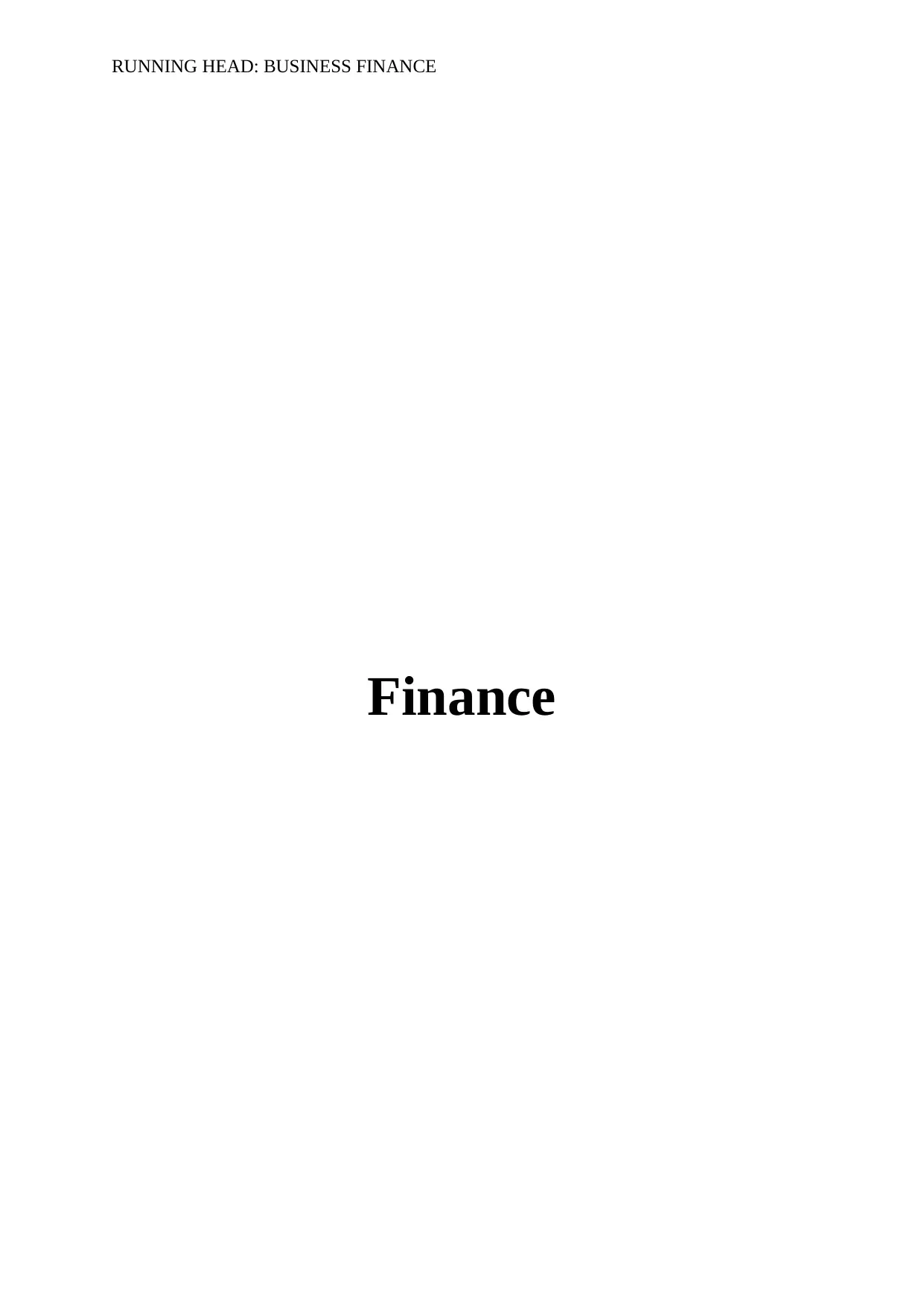
RUNNING HEAD: BUSINESS FINANCE
Finance
Finance
Paraphrase This Document
Need a fresh take? Get an instant paraphrase of this document with our AI Paraphraser
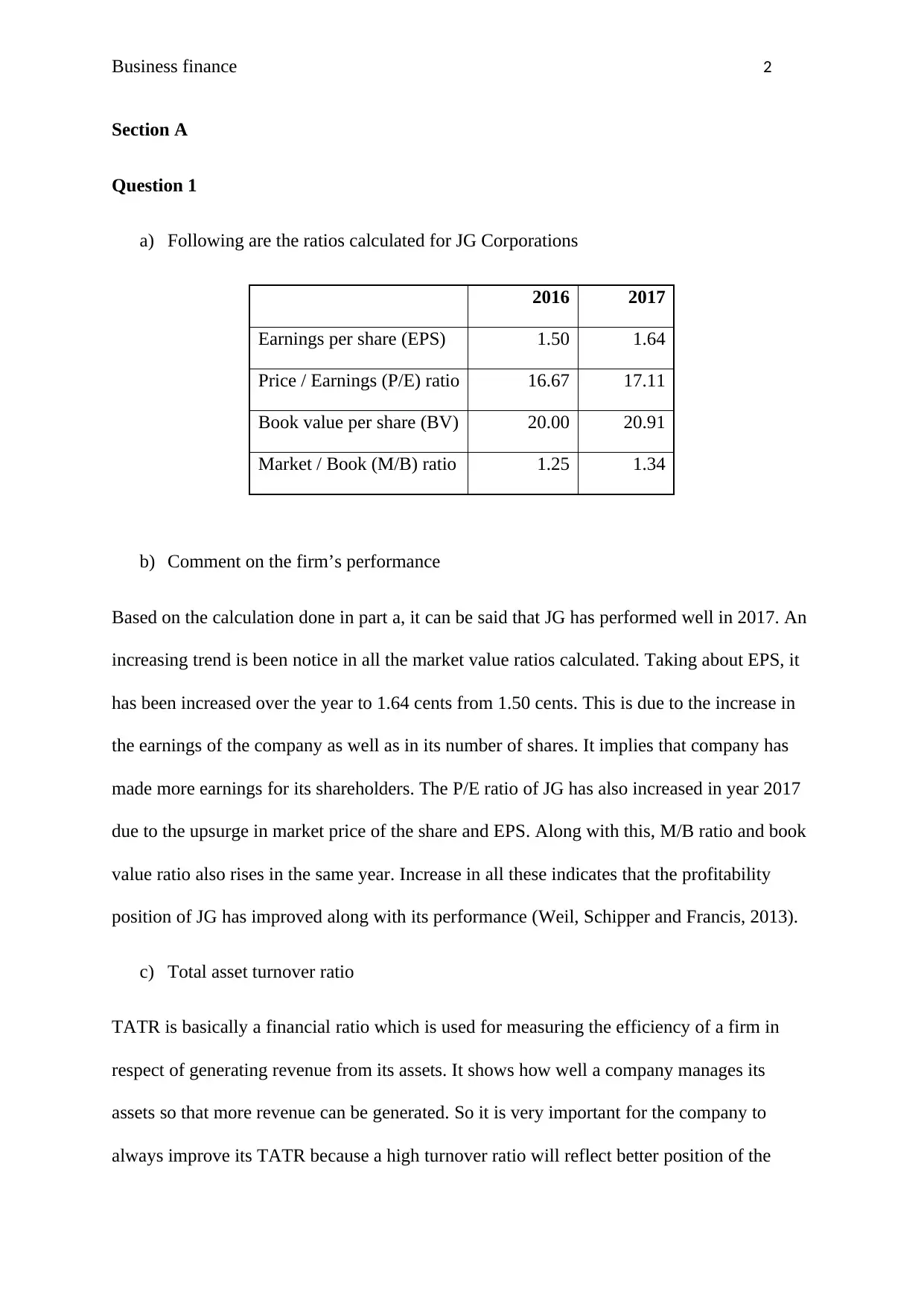
Business finance 2
Section A
Question 1
a) Following are the ratios calculated for JG Corporations
2016 2017
Earnings per share (EPS) 1.50 1.64
Price / Earnings (P/E) ratio 16.67 17.11
Book value per share (BV) 20.00 20.91
Market / Book (M/B) ratio 1.25 1.34
b) Comment on the firm’s performance
Based on the calculation done in part a, it can be said that JG has performed well in 2017. An
increasing trend is been notice in all the market value ratios calculated. Taking about EPS, it
has been increased over the year to 1.64 cents from 1.50 cents. This is due to the increase in
the earnings of the company as well as in its number of shares. It implies that company has
made more earnings for its shareholders. The P/E ratio of JG has also increased in year 2017
due to the upsurge in market price of the share and EPS. Along with this, M/B ratio and book
value ratio also rises in the same year. Increase in all these indicates that the profitability
position of JG has improved along with its performance (Weil, Schipper and Francis, 2013).
c) Total asset turnover ratio
TATR is basically a financial ratio which is used for measuring the efficiency of a firm in
respect of generating revenue from its assets. It shows how well a company manages its
assets so that more revenue can be generated. So it is very important for the company to
always improve its TATR because a high turnover ratio will reflect better position of the
Section A
Question 1
a) Following are the ratios calculated for JG Corporations
2016 2017
Earnings per share (EPS) 1.50 1.64
Price / Earnings (P/E) ratio 16.67 17.11
Book value per share (BV) 20.00 20.91
Market / Book (M/B) ratio 1.25 1.34
b) Comment on the firm’s performance
Based on the calculation done in part a, it can be said that JG has performed well in 2017. An
increasing trend is been notice in all the market value ratios calculated. Taking about EPS, it
has been increased over the year to 1.64 cents from 1.50 cents. This is due to the increase in
the earnings of the company as well as in its number of shares. It implies that company has
made more earnings for its shareholders. The P/E ratio of JG has also increased in year 2017
due to the upsurge in market price of the share and EPS. Along with this, M/B ratio and book
value ratio also rises in the same year. Increase in all these indicates that the profitability
position of JG has improved along with its performance (Weil, Schipper and Francis, 2013).
c) Total asset turnover ratio
TATR is basically a financial ratio which is used for measuring the efficiency of a firm in
respect of generating revenue from its assets. It shows how well a company manages its
assets so that more revenue can be generated. So it is very important for the company to
always improve its TATR because a high turnover ratio will reflect better position of the
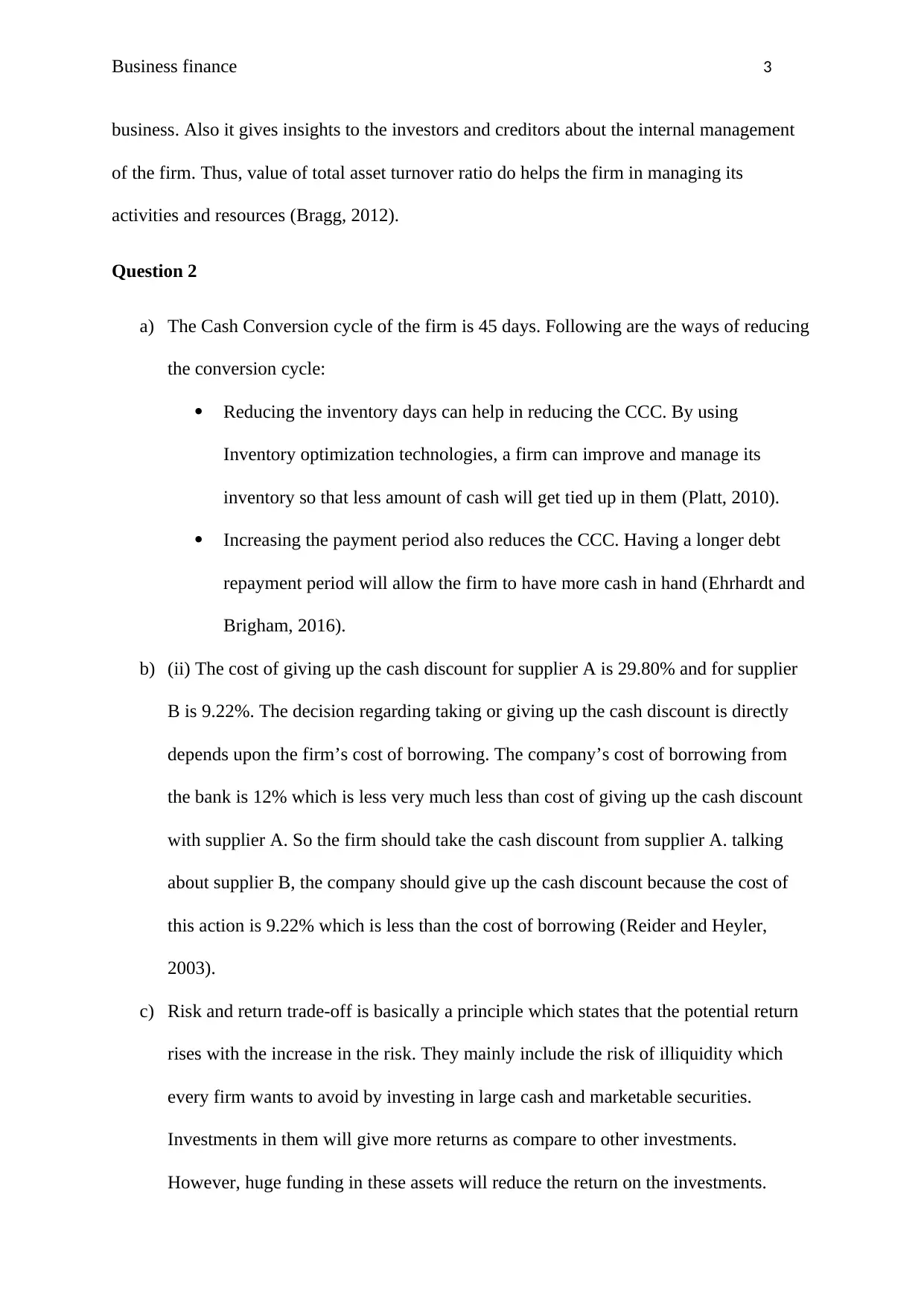
Business finance 3
business. Also it gives insights to the investors and creditors about the internal management
of the firm. Thus, value of total asset turnover ratio do helps the firm in managing its
activities and resources (Bragg, 2012).
Question 2
a) The Cash Conversion cycle of the firm is 45 days. Following are the ways of reducing
the conversion cycle:
Reducing the inventory days can help in reducing the CCC. By using
Inventory optimization technologies, a firm can improve and manage its
inventory so that less amount of cash will get tied up in them (Platt, 2010).
Increasing the payment period also reduces the CCC. Having a longer debt
repayment period will allow the firm to have more cash in hand (Ehrhardt and
Brigham, 2016).
b) (ii) The cost of giving up the cash discount for supplier A is 29.80% and for supplier
B is 9.22%. The decision regarding taking or giving up the cash discount is directly
depends upon the firm’s cost of borrowing. The company’s cost of borrowing from
the bank is 12% which is less very much less than cost of giving up the cash discount
with supplier A. So the firm should take the cash discount from supplier A. talking
about supplier B, the company should give up the cash discount because the cost of
this action is 9.22% which is less than the cost of borrowing (Reider and Heyler,
2003).
c) Risk and return trade-off is basically a principle which states that the potential return
rises with the increase in the risk. They mainly include the risk of illiquidity which
every firm wants to avoid by investing in large cash and marketable securities.
Investments in them will give more returns as compare to other investments.
However, huge funding in these assets will reduce the return on the investments.
business. Also it gives insights to the investors and creditors about the internal management
of the firm. Thus, value of total asset turnover ratio do helps the firm in managing its
activities and resources (Bragg, 2012).
Question 2
a) The Cash Conversion cycle of the firm is 45 days. Following are the ways of reducing
the conversion cycle:
Reducing the inventory days can help in reducing the CCC. By using
Inventory optimization technologies, a firm can improve and manage its
inventory so that less amount of cash will get tied up in them (Platt, 2010).
Increasing the payment period also reduces the CCC. Having a longer debt
repayment period will allow the firm to have more cash in hand (Ehrhardt and
Brigham, 2016).
b) (ii) The cost of giving up the cash discount for supplier A is 29.80% and for supplier
B is 9.22%. The decision regarding taking or giving up the cash discount is directly
depends upon the firm’s cost of borrowing. The company’s cost of borrowing from
the bank is 12% which is less very much less than cost of giving up the cash discount
with supplier A. So the firm should take the cash discount from supplier A. talking
about supplier B, the company should give up the cash discount because the cost of
this action is 9.22% which is less than the cost of borrowing (Reider and Heyler,
2003).
c) Risk and return trade-off is basically a principle which states that the potential return
rises with the increase in the risk. They mainly include the risk of illiquidity which
every firm wants to avoid by investing in large cash and marketable securities.
Investments in them will give more returns as compare to other investments.
However, huge funding in these assets will reduce the return on the investments.
⊘ This is a preview!⊘
Do you want full access?
Subscribe today to unlock all pages.

Trusted by 1+ million students worldwide
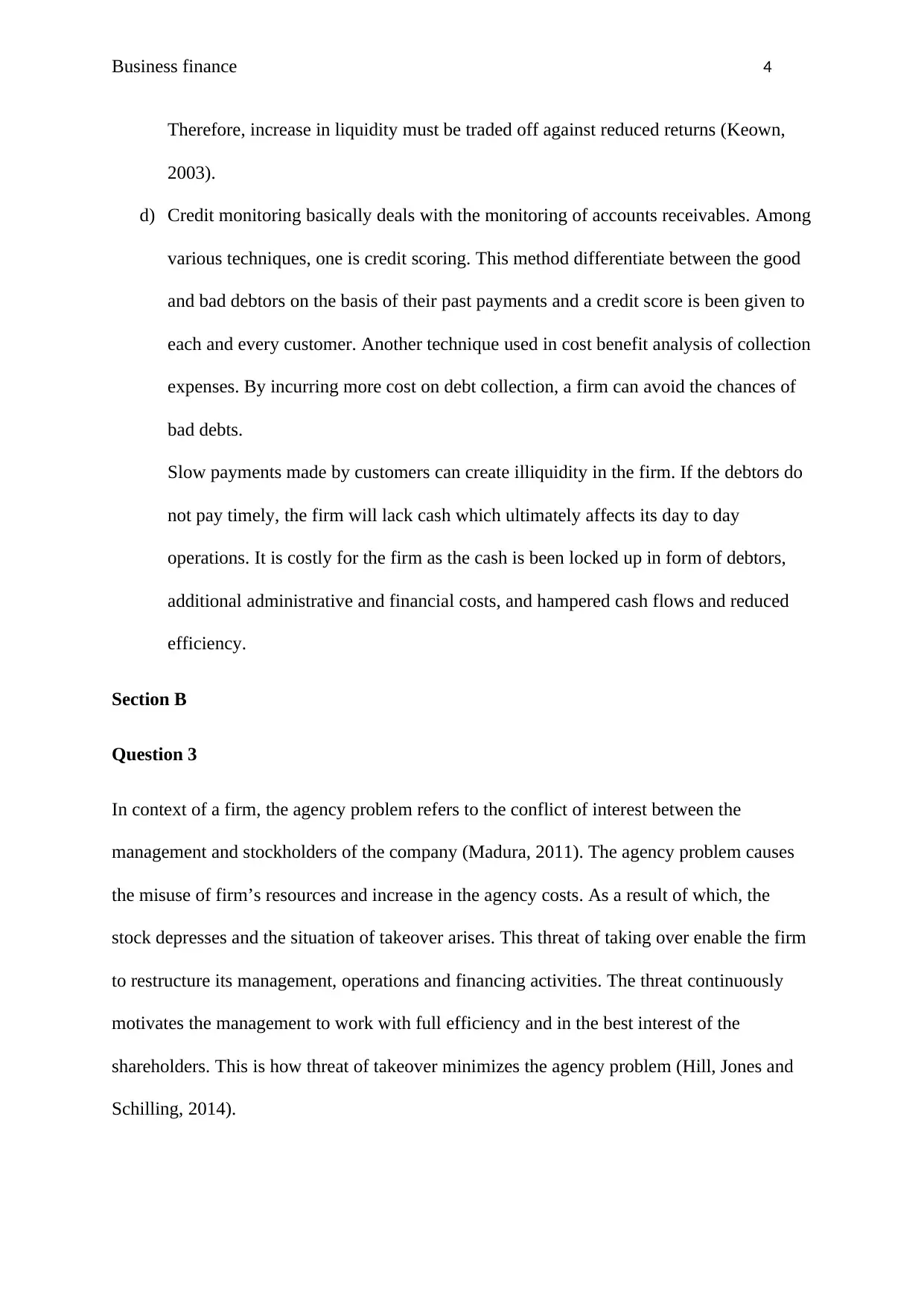
Business finance 4
Therefore, increase in liquidity must be traded off against reduced returns (Keown,
2003).
d) Credit monitoring basically deals with the monitoring of accounts receivables. Among
various techniques, one is credit scoring. This method differentiate between the good
and bad debtors on the basis of their past payments and a credit score is been given to
each and every customer. Another technique used in cost benefit analysis of collection
expenses. By incurring more cost on debt collection, a firm can avoid the chances of
bad debts.
Slow payments made by customers can create illiquidity in the firm. If the debtors do
not pay timely, the firm will lack cash which ultimately affects its day to day
operations. It is costly for the firm as the cash is been locked up in form of debtors,
additional administrative and financial costs, and hampered cash flows and reduced
efficiency.
Section B
Question 3
In context of a firm, the agency problem refers to the conflict of interest between the
management and stockholders of the company (Madura, 2011). The agency problem causes
the misuse of firm’s resources and increase in the agency costs. As a result of which, the
stock depresses and the situation of takeover arises. This threat of taking over enable the firm
to restructure its management, operations and financing activities. The threat continuously
motivates the management to work with full efficiency and in the best interest of the
shareholders. This is how threat of takeover minimizes the agency problem (Hill, Jones and
Schilling, 2014).
Therefore, increase in liquidity must be traded off against reduced returns (Keown,
2003).
d) Credit monitoring basically deals with the monitoring of accounts receivables. Among
various techniques, one is credit scoring. This method differentiate between the good
and bad debtors on the basis of their past payments and a credit score is been given to
each and every customer. Another technique used in cost benefit analysis of collection
expenses. By incurring more cost on debt collection, a firm can avoid the chances of
bad debts.
Slow payments made by customers can create illiquidity in the firm. If the debtors do
not pay timely, the firm will lack cash which ultimately affects its day to day
operations. It is costly for the firm as the cash is been locked up in form of debtors,
additional administrative and financial costs, and hampered cash flows and reduced
efficiency.
Section B
Question 3
In context of a firm, the agency problem refers to the conflict of interest between the
management and stockholders of the company (Madura, 2011). The agency problem causes
the misuse of firm’s resources and increase in the agency costs. As a result of which, the
stock depresses and the situation of takeover arises. This threat of taking over enable the firm
to restructure its management, operations and financing activities. The threat continuously
motivates the management to work with full efficiency and in the best interest of the
shareholders. This is how threat of takeover minimizes the agency problem (Hill, Jones and
Schilling, 2014).
Paraphrase This Document
Need a fresh take? Get an instant paraphrase of this document with our AI Paraphraser
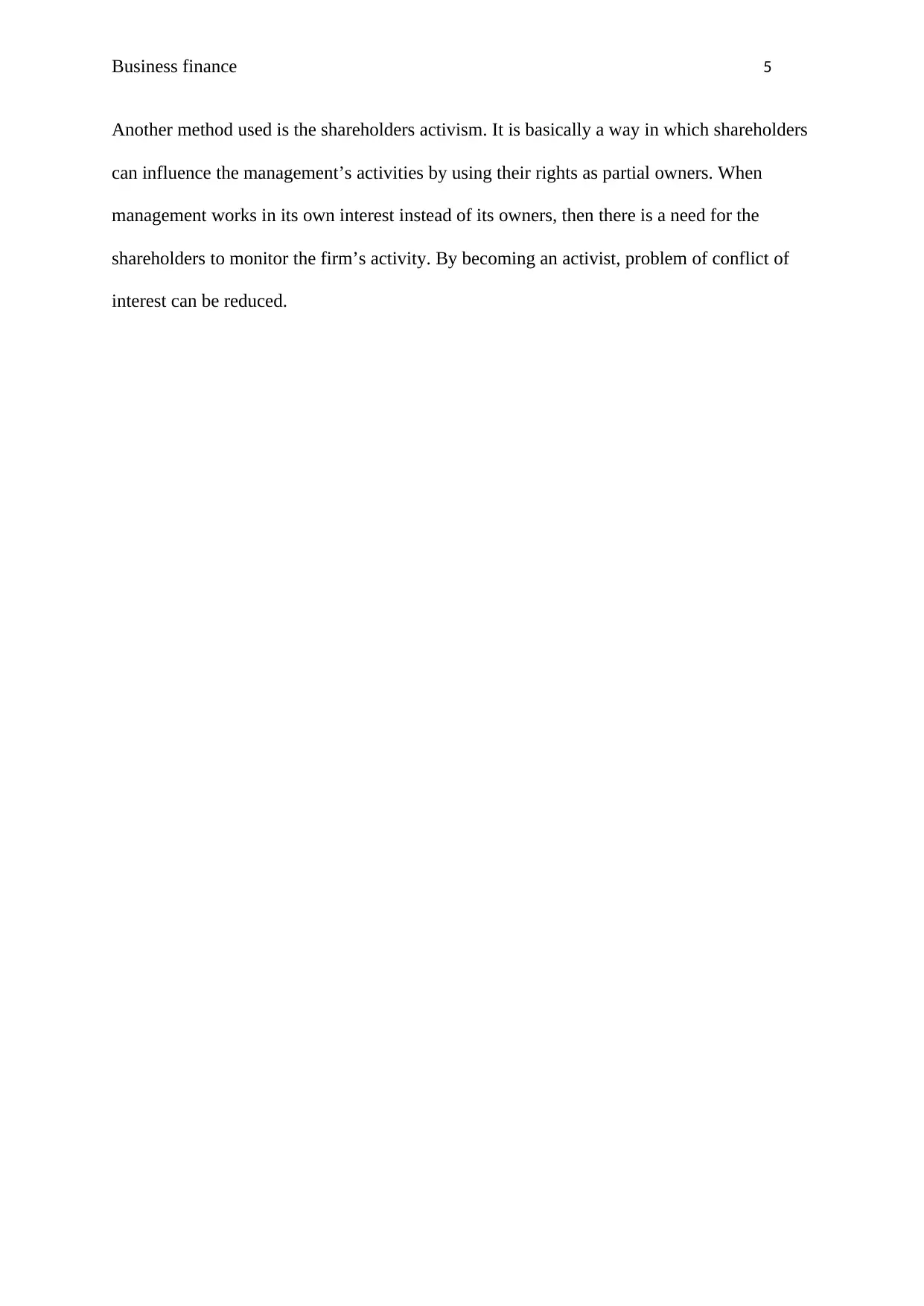
Business finance 5
Another method used is the shareholders activism. It is basically a way in which shareholders
can influence the management’s activities by using their rights as partial owners. When
management works in its own interest instead of its owners, then there is a need for the
shareholders to monitor the firm’s activity. By becoming an activist, problem of conflict of
interest can be reduced.
Another method used is the shareholders activism. It is basically a way in which shareholders
can influence the management’s activities by using their rights as partial owners. When
management works in its own interest instead of its owners, then there is a need for the
shareholders to monitor the firm’s activity. By becoming an activist, problem of conflict of
interest can be reduced.
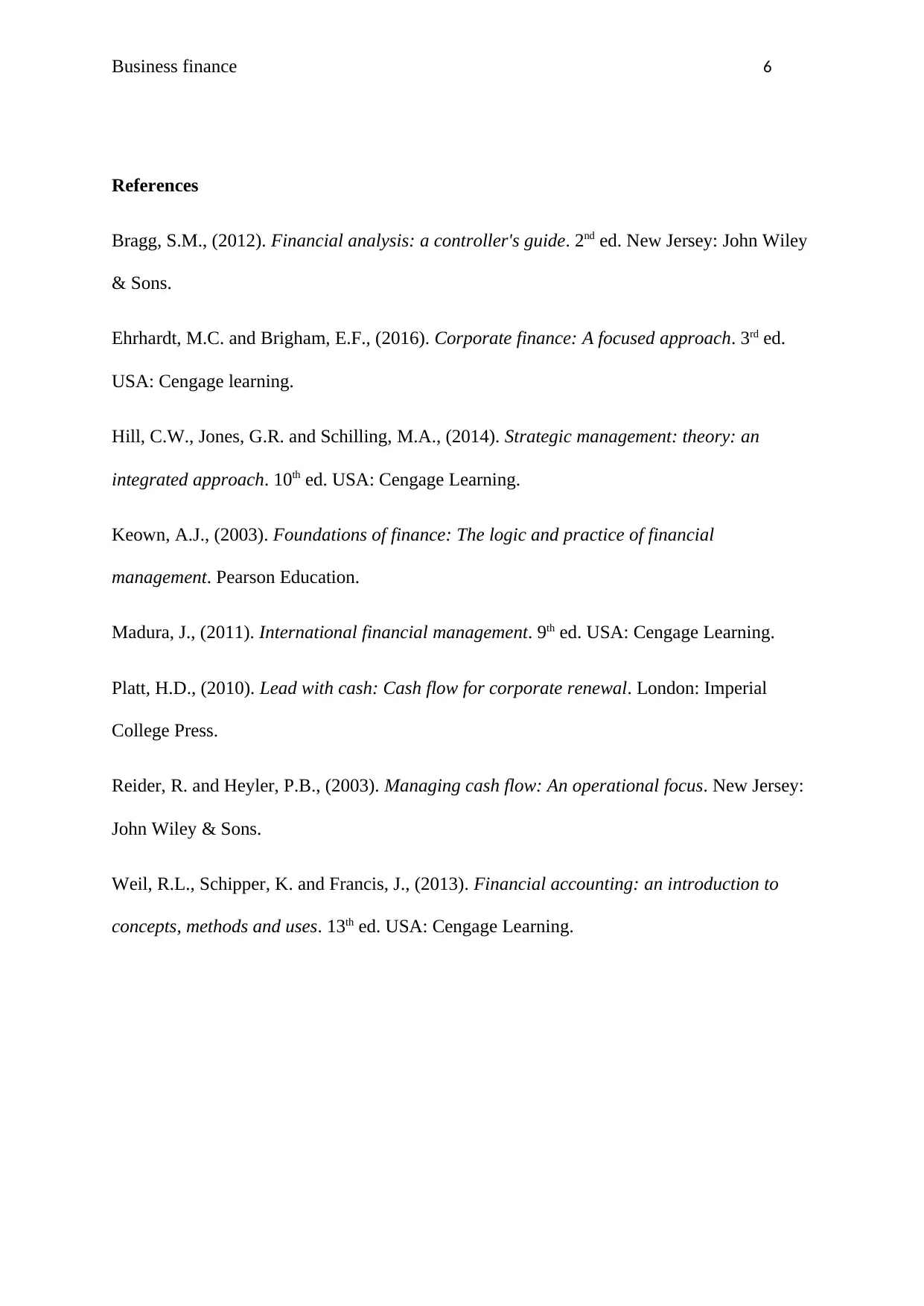
Business finance 6
References
Bragg, S.M., (2012). Financial analysis: a controller's guide. 2nd ed. New Jersey: John Wiley
& Sons.
Ehrhardt, M.C. and Brigham, E.F., (2016). Corporate finance: A focused approach. 3rd ed.
USA: Cengage learning.
Hill, C.W., Jones, G.R. and Schilling, M.A., (2014). Strategic management: theory: an
integrated approach. 10th ed. USA: Cengage Learning.
Keown, A.J., (2003). Foundations of finance: The logic and practice of financial
management. Pearson Education.
Madura, J., (2011). International financial management. 9th ed. USA: Cengage Learning.
Platt, H.D., (2010). Lead with cash: Cash flow for corporate renewal. London: Imperial
College Press.
Reider, R. and Heyler, P.B., (2003). Managing cash flow: An operational focus. New Jersey:
John Wiley & Sons.
Weil, R.L., Schipper, K. and Francis, J., (2013). Financial accounting: an introduction to
concepts, methods and uses. 13th ed. USA: Cengage Learning.
References
Bragg, S.M., (2012). Financial analysis: a controller's guide. 2nd ed. New Jersey: John Wiley
& Sons.
Ehrhardt, M.C. and Brigham, E.F., (2016). Corporate finance: A focused approach. 3rd ed.
USA: Cengage learning.
Hill, C.W., Jones, G.R. and Schilling, M.A., (2014). Strategic management: theory: an
integrated approach. 10th ed. USA: Cengage Learning.
Keown, A.J., (2003). Foundations of finance: The logic and practice of financial
management. Pearson Education.
Madura, J., (2011). International financial management. 9th ed. USA: Cengage Learning.
Platt, H.D., (2010). Lead with cash: Cash flow for corporate renewal. London: Imperial
College Press.
Reider, R. and Heyler, P.B., (2003). Managing cash flow: An operational focus. New Jersey:
John Wiley & Sons.
Weil, R.L., Schipper, K. and Francis, J., (2013). Financial accounting: an introduction to
concepts, methods and uses. 13th ed. USA: Cengage Learning.
⊘ This is a preview!⊘
Do you want full access?
Subscribe today to unlock all pages.

Trusted by 1+ million students worldwide
1 out of 6
Related Documents
Your All-in-One AI-Powered Toolkit for Academic Success.
+13062052269
info@desklib.com
Available 24*7 on WhatsApp / Email
![[object Object]](/_next/static/media/star-bottom.7253800d.svg)
Unlock your academic potential
Copyright © 2020–2025 A2Z Services. All Rights Reserved. Developed and managed by ZUCOL.





